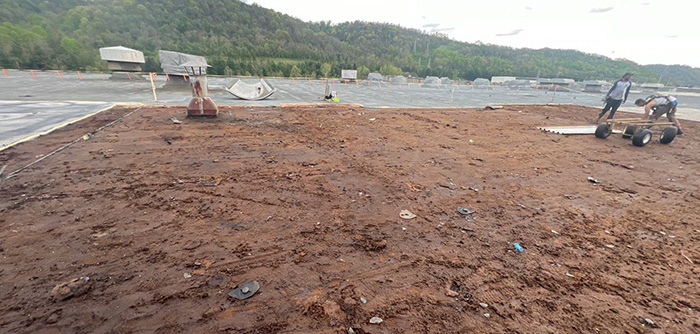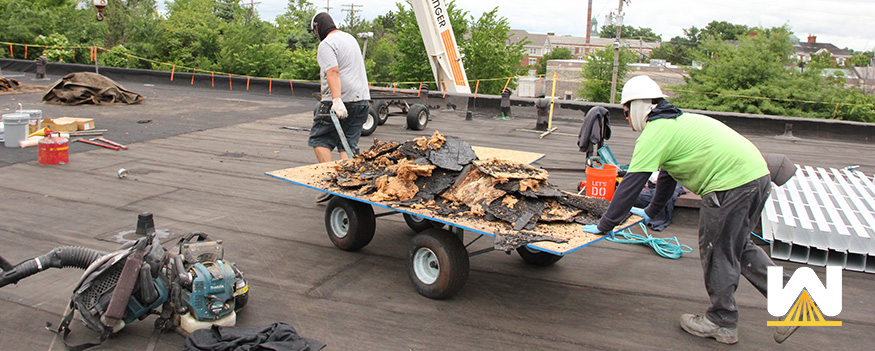You may be wondering, is my commercial roof in too bad of shape to repair or restore…and is a complete tear-off my only option?
In this article, you’ll learn the 3 factors that most likely will lean your project into “complete tear-off” territory:
- Terrible membrane condition
- Excessive wet insulation
- Excessive rotted decking
And just so you know, West Roofing Systems has been in commercial roofing since 1979. After doing a visual inspection, pulling core samples, and/or doing an infrared inspection, we can determine if a complete tear-off can be avoided or not. Giving this evidence to building owners gives them confidence that a tear-off is only done if it’s absolutely necessary.
Lastly, this article has been read, edited, and approved for publication by an internal commercial roofing expert (one of our owners) with more than 30+ years of experience.
The 3 factors that most likely will lean your project into “complete tear-off” territory
- Membrane is in bad condition
- Excessive wet insulation
- Excessive rotted decking
Let’s get started!
Membrane is in bad condition
Signs that the membrane is in bad condition and needs to be 100% torn off:
- If the membrane has seams that have lost a decent amount of adhesion to one another
- If the membrane is very old. For a single-ply roof that meets certain criteria, a 20-year warranty can be issued. If it’s year 25, it might be time for a complete tear-off
- If the membrane has excessive cuts, punctures, or is alligatoring (excessive sun exposure has dried out the membrane and now it’s cracking)
If only one roofing system is installed, you might be able to install a coverboard over the existing roof, and then install a new roofing system on top.
If two roofing systems are in place and the bottom system is dry, you might be able to only remove the top system and install something new.
If two roofing systems are installed and both are in poor condition, it might be beneficial (and necessary) to remove both systems 100% and start over.
Excessive wet insulation
When you pull up the membrane on your commercial roof, does the insulation look like this:

The board underneath the membrane is so saturated it looks like mud.
All wet insulation needs to be removed and replaced. This can be 10% of a roof, 30%, 85%, whatever it may be.
You should never install anything over wet insulation because it only causes future problems.
A threshold a lot of contractors use to determine a 100% tear-off or not is around 25% wet insulation.
- More than 25% wet insulation = 100% tear-off
- Less than 25% wet insulation = only remove and replace the wet areas
Excessive rotted decking


These pictures look crazy, huh?
How did the roof get to this point?
Well, this place was abandoned, so no people, products, or anything valuable was inside. There was no way to know it had been leaking for so long.
But now that there are plans to lease this space out, repairs need to be made.
If there’s a lot of bad decking, it could be the result of excessive wet insulation.
There’s no threshold correlating the amount of bad decking to a complete tear-off. Just be aware that there will be an estimated cost to remove and replace bad decking. It’s a safety hazard and a key component in the entire roof system, so it needs to be structurally sound.
In a proposal, you’ll likely see a caveat for removal and replacing bad decking. A sample proposal might be:
- Power wash the roof clean
- Remove and replace all wet insulation
- Remove and replace approximately 2000 sq. ft. of bad decking (an additional cost of $10 per sq. ft. of additional bad decking if found during the project. The owner will be notified before any additional bad decking is worked on)
Something along these lines.
Conclusion
Hopefully, you learned a little about how a commercial roofing contractor determines a complete tear-off or not.
Believe me, even though the project cost will be higher, roofing contractors don’t want to do tear-offs. It’s hard labor for the employees, which doesn’t make anyone happy.
But in some scenarios, the complete tear-off is the best option for the building owner.
NOTE: Before signing up for a complete tear-off, get evidence of excessive wet insulation, bad membrane, etc. through photos, core samples, or infrared inspections. Making owners do an unnecessary tear-off is a common unethical practice in commercial roofing.
Here are other articles you might find helpful:


